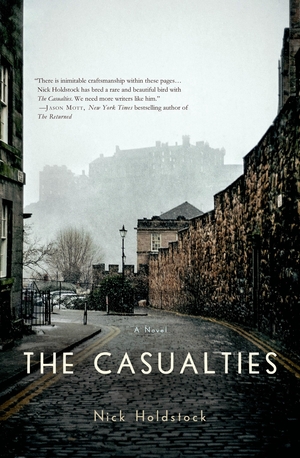
In a knowing nod to post-apocalyptic tales of horror, Nick Holdstock’s genre-defying novel The Casualties includes one near-zombie episode. Caitlin, a lonely woman who runs a charity clothing shop in Edinburgh’s Comely Bank neighborhood, wears heavy makeup to hide a disorder in which her facial skin constantly flakes off. As the condition worsens, she develops deep, bloody cuts in her cheeks. Shortly thereafter, Caitlin encounters children blocking a park path who scream to their parents that they’ve seen a zombie. The parents do nothing to discourage them, and a raging row ensues. Totally out of character, the usually meek and self-effacing Caitlin explodes with anger, unleashing fury on the parents and children and discovering a more assertive future self in the process.
 Mistaken identity aside, there are no real zombies in The Casualties, nor any scenes of post-apocalyptic devastation or gloom. The novel recounts events on a few contiguous blocks in Edinburgh, Scotland during the two years before a massive asteroid crashes into Earth in 2017. Its impact causes a catastrophic event roughly comparable to the collision widely credited with the Great Extinction at the end of the Cretaceous period, and it wipes out Europe and much of North America.
Mistaken identity aside, there are no real zombies in The Casualties, nor any scenes of post-apocalyptic devastation or gloom. The novel recounts events on a few contiguous blocks in Edinburgh, Scotland during the two years before a massive asteroid crashes into Earth in 2017. Its impact causes a catastrophic event roughly comparable to the collision widely credited with the Great Extinction at the end of the Cretaceous period, and it wipes out Europe and much of North America.
The narrative includes a few intermittent flashes forward to a time 60 years after the event, suggesting that the impact resulted in the immediate death of much of the world’s population, but there’s no discussion of an impact winter that followed. The Casualties’ narrator, reporting from the year 2077, says little about the immediate aftermath of the collision. As far as readers know, life went on without much interruption outside of the impact zone, with fallout more behavioral than environmental:
Our cities are cleaner; we commit less crime; we manage our desires. If there are no statues or plaques on our streets, it is because we prefer to look forward.
Although the apocalyptic event looms on the fringes of the narrative, the story Holdstock tells leading up to it is surprisingly quiet and inwardly focused—appropriately enough for a population that has absolutely no inkling of its imminent destruction. If anything, their moods were governed by much more mundane weather patterns. As the narrator describes the summer of 2016,
The light before a shadow falls in memory seems brighter. But even allowing for minor exaggeration, these were halcyon days for Comely Bank. You could see it in people’s faces. Whatever else was wrong with their lives, at least they were no longer living beneath clouds … Their minds were as the sky above: calm, untroubled, clear.
As an often-prickly portrait of a quiet, ill-fated, urban UK neighborhood, the novel differs markedly from, say, John Lanchester’s Capital only inasmuch as The Casualties’ Comely Bank (along with every other UK, European and North American street) will soon feel the world-ending impact of a meteor rushing toward Earth.
The narrator tells the story all-but-omnisciently from the future, including who survived (by luckily leaving before the impact) and who didn’t, and often reflects on how the meteor’s impact divided time and the lives of those who avoided it. Until the last pages of the book, we have only scattered clues as to the relationship of the narrator to the residents of Comely Bank before their world ended.
Comely Bank is the sort of neighborhood where residents greet each other, shop in each other’s stores and take an often-unhealthy interest in each other’s affairs. “In this real-but-not-real place,” the narrator reflects, “all the people I remember are always in the same spot, like actors on their mark.”
The central character is Sam Clark, the 26-year-old owner of a used bookstore that raises money for a children’s charity. Ever since his parents abandoned him without warning, Sam has spent the last 10 years living alone in the house he grew up in. Their departure has left him in a persisting liminal state, at once the dumbstruck 16-year-old boy anxiously awaiting his parents’ return and also the compulsively curious 26-year-old man observing his own life and those of his neighbors from a measured distance.
Sam has three women in his life, albeit tangentially: the aforementioned Caitlin, who runs her clothing shop on the same block as his bookstore and has been nursing a crush on Sam for years, often fantasizing vividly on their union; Sinead, a sex-obsessed, Goth-girl au pair determined to abstain from sex since a recent abortion, but pre-occupied with Sam to the point of stalking and photographing him for months; and Malea, a Filipino prostitute whom Sam sees every Wednesday and ultimately resolves to liberate from her miserable Edinburgh existence.
Other quirky Comely Bank denizens include Sinead’s charge Toby, a massive, mentally challenged boy-man whose uncontrollable appetite is appeased only (and only temporarily) by watching cooking shows; devout Catholic widowed schoolteacher Mrs. MacLean; perpetually drunk homeless couple Sean and Rita, who live in the park and practice a decided distaste for other homeless people; and convenience store owner Mr. Asham, also a client of Malea, who serially abuses her.
Intermittently, Sam also has a roommate, Alasdair, a homeless amnesiac who (when he’s not bunking with Sam) lives under a bridge. Alasdair freely shares his strong views about the causes of and solutions to his neighbors’ deficiencies and deformities, as well as the redemptive advantages of jettisoning possessions and unwanted identities. Alasdair is a terrible houseguest; he stores his own urine for drinking, and constantly destroys Sam’s furniture and other possessions.
Alasdair’s pre-occupation with shedding identities and past lives, in an odd way, largely informs the narrator’s belief in a clean separation between past and present identities. More than a disembodied voice in his or her own time, the narrator clearly knows the lives of Comely Bank’s long-gone residents with the intimacy of someone who lived among them, but describes them from a remove greater than the 60 years that separates them. The narrative suggests that that is just as it should be:
Those who survived the Black Death, the Holocaust, the Siege of Leningrad may have kept the same names, may have resumed the trades they had practiced before, slept in the same beds with the same people, but they were, each one of them, now cast from different metal.
In his own way, Holdstock plumbs the depths of Sam Spade’s Flitcraft parable—albeit with depths Spade himself rejected. In Dashiell Hammett’s The Maltese Falcon, private investigator Sam Spade tells the story of a man named Flitcraft who was walking to work one day and missed, by inches, being killed by a falling metal beam dropped from a construction site. Realizing how narrowly he escaped certain death, Flitcraft kept on walking, leaving behind his job, his family and his entire life, never to be heard from again. When Spade is hired by Flitcraft’s wife to track him down, he finds Flitcraft living in another city, with a new family and an identical job, essentially living the same life under a new name.
A half-century later, novelist Paul Auster made much more of Flitcraft’s story than Hammett did, seeing in it not merely alternate interpretive possibilities but the world-shaking implications of lives containing multitudes of other lives. Holdstock plants his feet firmly in the Auster camp.
That said, The Casualties is far more than a weighty meditation on such existential conundrums. Part of the advantage of writing an apocalyptic story without a dramatized apocalypse—and especially without depicting a ravaged, smoke-seared post-apocalyptic world—is that Holdstock gets to avoid the clichés of the genre. But The Casualties still delivers just the right amount of world-beyond perspective without wallowing in the wreckage.
Speaking half about interpersonal neighborhood conflicts and half about apocalyptic impacts, Holdstock’s narrator reflects, “There are no clean collisions.” But the collision that divides the two narrative “nows” splits lives and time with a decisiveness that appears impossibly clean—and improbably enough, that’s what makes this decidedly un-apocalyptic world’s end novel so surprising and compelling.